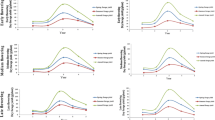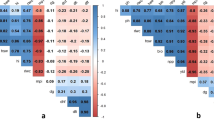Abstract
Genetic analysis of root and physiological traits and selection of genotypes with higher drought tolerance through these traits is generally limited in tall fescue. In this study, some parental genotypes of tall fescue first were assessed for field drought tolerance in 2014–2015 and then the polycross seeds were harvested to provide half-sib families. Sixteen half-sib families along with their corresponding parental genotypes were assessed in a pot experiment for root and physiological characteristics under three irrigation levels (control, mild and intense) in 2016. The results showed that drought stress decreased dry forage yield (DFY), relative water content and total chlorophyll and increased carotenoid and proline in both parental genotypes and half-sib families. Intense drought stress decreased most of the root traits at 0-30 cm soil depth while at 30–60 cm depth length, area, volume and dry weight of roots were increased. A broad range of general combining ability (GCA) was observed for DFY (21M and 9E), root (21M, 12L and 20L) and physiological characteristics (12L and 9E) at three irrigation levels. Moderate to high estimates of narrow sense heritability (0.40–0.72) as well as genetic variation for root and physiological traits, indicated that phenotypic selection can be successful to attain genetic progress. Indirect selection to improve DFY was more effective through selection for root and some physiological traits. Significant associations of root and some physiological traits with drought tolerance demonstrated that these traits could be used as appropriate selection criteria to elevate forage yield and identify superior genotypes for arid and semi-arid regions.


Similar content being viewed by others
References
Aastiveit AH, Aastiveit K (1990) Theory and application of open-pollination and polycross in forage grass breeding. Theor Appl Genet 79:618–624
Allen RG, Pereira LS, Raes D, Smith M (1998) Crop evapotranspiration: guidelines for computing crop requirements. FAO Irrigation and Drainage paper 56:41–51
Amini F, Majidi MM, Mirlohi A (2013) Genetic and genotype × environment interaction analysis for agronomical and some morphological traits in half-Sib families of tall fescue. Crop Sci 53:411–421
Anjum SA, Xie XY, Wang LC, Saleem MF, Man C, Lie W (2011) Morphological, physiological and biochemical responses of plants to drought stress. Afr J Agric Res 6:2026–2032
Arnon DI (1949) Copper enzymes in isolated chloroplast. Polyphenol oxidase in Beta vulgaris. Plant Physiol 24:1–15
Asseng S, Ritchie JT, Smucker AJM, Robertson MJ (1998) Root growth and water uptake during water deficit and recovering in wheat. Plant Soil 201:265–273
Bajji M, Lutts S, Kinet JM (2001) Water deficit effects on solute contribution to osmotic adjustment as a function of leaf ageing in three durum wheat (Triticum durum Desf.) cultivars performing differently in arid conditions. Plant Sci 160:669–681
Bates LS, Waldren RP, Teare LD (1973) Rapid determination of free proline for water-stress studies. Plant Soil 39:205–207
Blum A (2011) Plant breeding for water limited environments. Springer, New York
Bonos SA, Rush D, Hignight K, Meyer WA (2004) Selection for deep root production in tall fescue and perennial ryegrass. Crop Sci 44:1770–1775
Bowley SR, Christie RB (1981) Inheritance of dry matter yield in a heterozygous population of alfalfa. Can J Plant Sci 61:313–318
Carrow RN, Duncan RR (2003) Improving drought resistance and persistence in turf-type tall fescue. Crop Sci 43:978–984
Chloupek O, Skacel M, Ehrenbergerova J (1999) Effect of divergent selection for root size in field-grown alfalfa. Can J Plant Sci 79:93–95
Dacosta M, Hung B (2006) Osmotic adjustment associated with variation in Bentgrass tolerance to drought stress. J Am Soc Hortic Sci 131:338–344
Dencic S, Kastori R, Kobiljski B, Duggan B (2000) Evaluation of grain yield and its components in wheat cultivates and landraces under near optimal and drought conditions. Euphytica 113:43–52
Ebrahimiyan M, Majidi MM, Mirlohi A, Gheysari M (2012) Drought tolerance indices in a tall fescue population and its polycross progenies. Crop Pasture Sci 63:360–369
Ebrahimiyan M, Majidi MM, Mirlohi A, Noroozi A (2013) Physiological traits related to drought tolerance in tall fescue. Euphytica 190:401–414
Edwards JH, Jeffrey FP, Kingery RC (1990) Heritability of root characteristics affecting mineral uptake in tall fescue. Agron Hortic 135:93–96
Ekanayake IJ, Toole JCO, Garrity DP, Massajo TM (1985) Inheritance of root characteristics and their relation to drought tolerance in rice. Crop Sci 25:927–933
Ennos RA (1985) The significance of genetic variation for root growth within a natural population of white clover (Trifolium repens). J Ecol 73:615–624
Falconer DS, Mackay TFC (1996) Introduction to quantitative genetics. Longman, Harlow
Falconern DS (1989) Introduction to quantitative genetics, 3rd edn. Longman, London
Farre L, Faci JM (2009) Deficit irrigation in maze for reducing agricultural water use in a mediterranean enviroment. Agric Water Manag 96:383–394
Fernandez GCJ (1992) Effective selection criteria for assessing plant stress tolerance. In: Kuo CC (ed.), Proceedings of an international symposium on adaptation of food crops to temperature and water stress. AVRDC, Shanhua, Taiwan, pp. 257–270
Flexas J, Bota J, Loreto F, Cornic G, Sharkey TD (2004) Diffusive and metabolic limitations to photosynthesis under drought and salinity in C3 plants. Plant Biol 6:1–11
Galkovskyi T, Mileyko Y, Bucksch A, Moore B, Symonova O, Price CA, Topp CN, Iyer-Pascuzzi AS, Zurek PR, Fang S, Harer J, Benfey PN, Weitz JS (2012) GiA roots: software for the high-throughput analysis of plant root system architecture. BMC Plant Biol 12:116
Gallardo M, Jackson LE, Thompson RB (1996) Shoot and root physiological responses to localized zones of soil moisture in cultivated and wild lettuce (Lactuca spp.). Plant, Cell Environ 19:1169–1178
Gewin V (2010) Food: an underground revolution. Nature 466:552–553
Gheysari M, Sadeghi SH, Loescher HW, Amiri S, Zareian MJ, Majidi MM, Asgarinia P, Payero JO (2017) Comparison of deficit irrigation management strategies on root, plant growth and biomass productivity of silage maize. Agric Water Manag 182:126–138
Gould SH (1955) The methods of archimedes. The American mathematical monthly 62:473–476
Hayat S, Hayat Q, Alyemeni MN, Wani AS, Pichtel J, Ahmad A (2012) Role of proline under changing environments. Plant Signal Behav 7:1456–1466
Huang B, Gao H (2000) Root physiological characteristics association with drought resistance in tall fescue cultivars. Crop Sci 40:196–203
Hura T, Grzesiak S, Hura K, Thiemtm E, Tokarz K, Wedzony M (2007) Physiological and biochemical tools useful in drought tolerance detection in genotypes of winter triticale: accumulation of Ferulic acid correlates with drought tolerance. Ann Bot 100:767–775
IPCC (2014) Intergovernmental Panel on Climate Change 5th Assessment Report (AR5)- Climate Change 2014: Impacts, Adaptation, and Vulnerability
Irani S, Majidi MM, Mirlohi A, Zargar M, Karami M (2015) Assessment of drought tolerance in sainfoin: physiological and drought tolerance indices. Agron J 107:1771–1781
Jiang Y, Huang B (2001) Drought and heat stress injury to two cool-season turfgrass in relation to antioxidant metabolism and lipid peroxidation. Crop Sci 41:436–442
Johanson RA, Wichern DW (2007) Applied multivariate statistical analysis. Prentice Hall Inter. Inc, New Jersey
Karcher DE, Richardson MD, Hignight K, Rush D (2008) Drought tolerance of tall fescue populations selected for high root/shoot ratios and summer survival. Crop Sci 48:771–777
Kearsey MJ, Pooni HS (1996) The genetical analysis of quantitative traits. Chapman and Hall, New York
Keles Y, Oncel I (2004) Growth and solute composition in two wheat species experiencing combined influence of stress conditions. J Plant Physiol 51:228–233
Khalid KHA (2006) Influence of water stress on growth, essential oil and chemical composition of herbs (Ocimum sp.). Agrophysics 20:289–296
Kiani M, Gheysari M, Mostafazadeh-Farda B, Majidi MM, Karchani K, Hoogenboom G (2016) Effect of the interaction of water and nitrogen on sunflower under drip irrigation in an arid region. Agric Water Manag 171:162–172
Lehman VG, Engelke MC (1991) Heritability estimates of creeping bentgrass root systems grown in flexible tubes. Crop Sci 31:1680–1684
Leilah AA, Al-Khateeb SA (2005) Statistical analysis of wheat yield under drought conditions. J Arid Environ 61:483–496
Majidi MM, Mirlohi A, Amini F (2009) Genetic variation, heritability and correlations of agro-morphological traits in tall fescue (Festuca arundinacea Schreb). Euphytica 167:323–331
Man D, Bao YX, Han LB (2011) Drought tolerance associated with proline and hormone metabolism in two tall fescue cultivars. Hort Sci 46:1027–1032
Merewitz E, Meyer W, Bonos S, Huang BR (2010) Drought stress responses and recovery of Texas × Kentucky hybrids and Kentucky bluegrass genotypes in temperate climate conditions. Agron J 102:258–268
Moghaddam A, Vollmann J, Wanek W, Ardakani MR, Raza A, Pietsch G, Friedel JK (2012) Suitability of drought tolerance indices for selecting alfalfa (Medicago sativa L.) genotypes under organic farming in Austria. Crop Breed 2:79–89
Nguyen HT, Sleper DA (1983) Theory and application of half sib matings in forage grass breeding. Theor Appl Genet 64:187–196
Pirnajmedin F, Majidi MM, Gheysari M (2015) Root and physiological characteristics associated with drought tolerance in Iranian tall fescue. Euphyica 202:141–155
Pirnajmedin F, Majidi MM, Gheysari M (2016) Survival and recovery of tall fescue genotypes: association with root characteristics and drought tolerance. Grass Forage Sci 202:141–155
Puig J, Pauluzzi G, Guiderdoni E, Gantet P (2012) Regulation of shoot and root development through mutual signaling. Mol Plant 5:574–583
Rechinger KH (1970) Flora Iranica. Graz. Austria: No.70
Reddy AR, Chaitanya KV, Vivekanandan M (2004) Drought induced responses of photosynthesis and antioxidant metabolism in higher plants. J Plant Physiol 161:1189–1202
Ritchi SW, Naguyen HT, Holiday AS (1990) Leaf water content and gas exchange parameters of two wheat genotypes differing in drpught resistance. Crop Sci 30:105–111
Rong Hua L, Guo PG, Michel B, Stefania G, Salvatore C (2006) Evaluation of chlorophyll content and fluorescence parameter as indicator of drought tolerance in barley. Agric Sci China 5:751–757
Rudoplh AS, Crowe JH, Crowe LM (1986) Effects of three stabilizing agents-proline, betaine, and trehalose on membrane phospholipids. Arch Biochem Biophys 245:134–143
SAS institute (2001) User,s guide. Release 9.2 SAS Institute, Cary N. C. Nos SAS and SSSA, Madison, W. pp 225–293
Searle SR (1965) The value of indirect selection.I. Mass selection. Biometrics 21:682–707
Serraj R, Krishnamurthy L, Kashiwagi J, Kumar J, Chandra S, Crouch JH (2004) Variation in root traits of chickpea (Cicer arietinum L.) grown under terminal drought. Field Crops Res 88:115–127
Sheffer KM, Dunn JH, Minner DD (1987) Summer drought response and rooting depth of three cool- season turfgrasses. Hort Sci 22:296–297
Simkin AJ, Moreau H, Kuntz M, Pagny G, Lin C, Tanksley S, Mc Carthy J (2008) An investigation of carotenoid biosynthesis in Coff canephora and Coffea arabic. J Plant Physiol 165:1087–1106
Sokolovic D, Babic S, Radovic J, Milenkovic J, Lugic Z, Andjelkovic S, Vasic T (2013) Genetic variation of root characteristics and deep root production in perennial ryegrass cultivars contrasting in field persistency. Breeding strategies for sustainable forage and turf grass improvement. pp 275–281
Statgraphics (2016) Statgraphics. Version 17.2.1: Stat Point Inc
Vries FT, Brown C, Stevens CJ (2016) Grassland species root response to drought: consequences for soil carbon and nitrogen availability. Plant Soil 409:297–312
Wang Z, Huang B (2004) Physiological recovery of kentuky bluegrass from simultaneous drought and heat stress. Crop Sci 44:1729–1736
Wang H, Siopongco J, Wade L, Yamauchi A (2009) Fractal analysis on root systems of rice plants in response to drought stress. Environ Exp Bot 65:338–344
Wasson AP, Richards RA, Chatrath R, Misra SC, Sai Prasad SV, Rebetzke GJ, Kirkegaard JA, Christopher J, Watt M (2012) Traits and selection strategies to improve root systems and water uptake in water-limited wheat crops. J Exp Bot 63:3485–3498
Wilson A, Punginelli C, Gall A, Bonetti C, Alexandre M, Routaboul JM (2008) A photoactive carotenoid protein acting as light intensity sensor. Proc Natl Acad Sci USA 105:12075–12080
Wricke G, Weber WE (1986) Quantitative genetics and selection in plant breeding. Walter de Gruyter, New York
Author information
Authors and Affiliations
Corresponding author
Electronic supplementary material
Below is the link to the electronic supplementary material.
Rights and permissions
About this article
Cite this article
Pirnajmedin, F., Majidi, M.M., Saeidi, G. et al. Genetic analysis of root and physiological traits of tall fescue in association with drought stress conditions. Euphytica 213, 135 (2017). https://doi.org/10.1007/s10681-017-1920-6
Received:
Accepted:
Published:
DOI: https://doi.org/10.1007/s10681-017-1920-6




